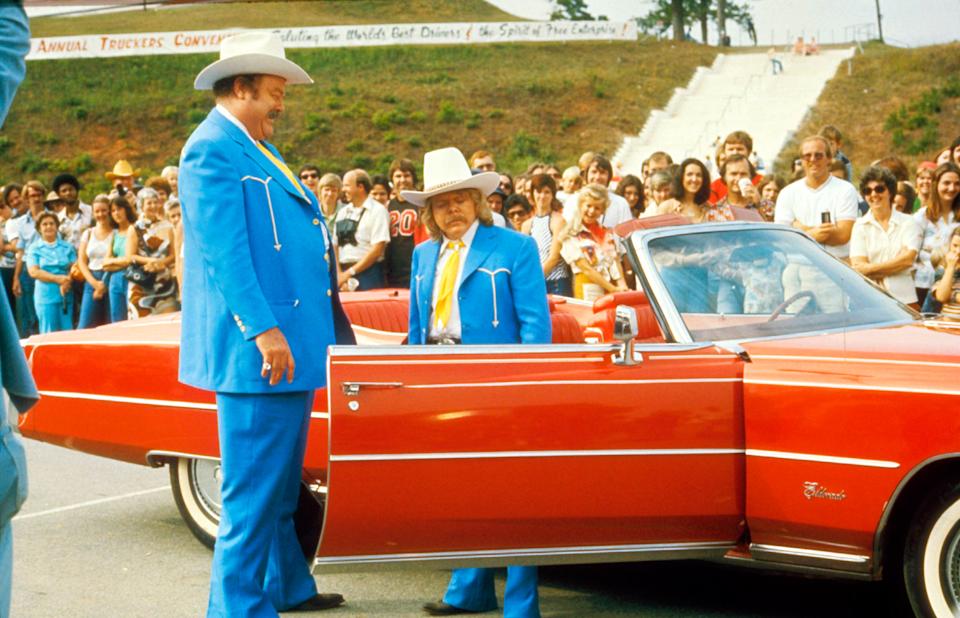Han Solo may be the galaxy’s best smuggler, but back here on terra firma, no one outraces the Bandit. Forty-five years ago, Smokey and the Bandit went head to head with Star Wars over the long Memorial Day weekend, and while George Lucas’s space opera emerged as 1977’s biggest hit, audiences happily went “East Bound and Down” with Burt Reynolds’s boisterous bootlegger over and over again. Moviegoers now have a fresh chance to experience the movie on the big screen: Smokey is part of the TCM Big Screen Classic series hosted by Fathom Events, and screenings are set for May 29, June 1 and June 2.
Helmed by stuntman-turned-director Hal Needham, Smokey and the Bandit sped to a mighty $126 million, lapping the domestic gross of Steven Spielberg’s Close Encounters of the Third Kind. It also became part of the pop culture firmament of the American South, where it’s viewed as being more than just a smashing good time.
“Billy Bob Thornton once said that, in the South, Smokey and the Bandit is considered a documentary,” songwriter-actor Paul Williams tells Yahoo Entertainment with a laugh. “It’s just culturally so interwoven. If there was ever a film that acted as kind of a clubhouse for a time and place, it’s Smokey and the Bandit.”
Williams’s screen time in Smokey is relatively brief, but he makes an immediate impression as Little Enos Burdette, who sets the movie’s cavalcade of car crashes in motion alongside his on-screen dad (and off-screen friend), Big Enos, played by Pat McCormick. Credit for that goes to their matching blue suits, which tipped Williams off to the spirit of the enterprise he had joined. “I remember Pat walking into the room wearing his version of the suit, and I thought: ‘Sure, he gets the great costume!’ And then I realized: ‘Wait a minute, I’ve got the same one here!”
[embedded content]
According to Williams, it was Reynolds’s idea to cast the height-mismatched duo as the father and son who dispatch the Bandit to snag some celebratory cases of Coors Beer while avoiding the long arm of the law, aka “Smokey,” represented by Sheriff Buford T. Justice, played by The Honeymooners star Jackie Gleason. Along the way, the protagonist picks up runaway bride, Carrie (Sally Field), and gives her a literal crash course in the pleasures and perils of life in the smuggling game.
At the time, McCormick was a writer at The Tonight Show With Johnny Carson, where Williams — who had written hit songs for Barbra Streisand and The Carpenters, and collaborated with Jim Henson on The Muppet Movie and Emmet Otter’s Jug-Band Christmas — made regular appearances. Reynolds was hosted by Carson one night, and noticed their off-camera camaraderie. “He looked at the two of us, and said: ‘I’ve got an idea,'” Williams remembers. “After that, we were off and running.” Funnily enough, their run in the Smokey franchise outlasted the original stars: McCormick and Williams returned for the 1980 sequel and the third installment in 1983, by which point Reynolds and Field had bailed.
Although Smokey and the Bandit‘s script is credited to three screenwriters, Williams says that he and McCormick ad-libbed most of their Big and Little Enos material. (“We weren’t exactly Faulkner,” he admits with a laugh.) And he remembers that Reynolds — who died in 2018 — set the tone for the movie’s down-home attitude. “Burt was probably a better actor than he was ever recognized for, but he was also the world’s greatest movie star, and he loved being a movie star.”
In a spirited conversation, Williams shared more Reynolds stories from the Smokey set and revealed how the film cleared the path for his own journey to sobriety.
Burt Reynolds is so effortlessly charming in Smokey and the Bandit. Did you notice him switching between Burt and the Bandit on set?
I think they were the one and the same! It was the easiest acting job in the world for him, you know? There was a certain level of comfort for him on Smokey. First of all, Hal Needham was just fantastic, and they were tight buddies. They were always in the football huddle together on set, and I often wondered what actually was being shared in those huddles. Were they talking about the next shot or was it more like, “What are you doing later?” [Laughs]
That was the kind of friendship that existed between the two of them, and it was a connection that was very different from the Hollywood elite. There’s something about stuntmen in terms of the respect for the level that these guys work at. I think that’s kind of where Burt’s confidence as an actor came from — his football days and his stunt work. I mean, that’s just a guess! Burt never said: “Sit down, Paul, I want to talk to you about what gives me the confidence to be Burt Reynolds, and then you can try it.”
He and Sally Field were famously in a relationship at that time. Was their romance known about on set?
Yeah, I think so. I don’t really remember. There’s this horrible expression from the Humphrey Bogart and Frank Sinatra days where you would talk about some wonderful woman and call her a “broad.” That was once the greatest compliment in the world. And there was something about Sally Field from the moment that I met her where I saw that she had that kind of energy. It’s a classiness and a friendliness and an ease to be around. I loved her, and I think everybody did. I think the whole world had a crush on Sally Field.
[embedded content]
I understand that you father died in a car accident when you were young. Did that make the movie’s wild stunts hard for you to watch?
No, but that’s a good question! I’ve never been asked that before. I’ve always loved high speeds. I mean, I drive a BMW M2 Competition, and that goes 160 miles an hour. I also raced for Toyota, I did the Long Beach Grand Prix five times, and I’ve raced at Sears Point [now Sonoma Raceway]. I always joke that if I could see over the dash, I could win! Any short joke in a storm. [Laughs]
But I love automobiles, so [my father’s death] was not an element. I’ve always been fascinated by the way stunts are rigged, too. I’d wonder, “How did they get the train to hit only the back of the car on the tracks?” And then I’d learn that they’d take cable and tie it to the front of the car, and then tie it to the back of the train. So when the train is going forward, it’s pulling the car up to where the point where if the cable doesn’t stretch, it will hit the exact right spot. So I’ve always had great respect for that world and how courageous they are and what amazing athletes they all are.
I’m also a recovering drug addict and alcoholic — I’m 32 years sober. Around the time of Smokey and the Bandit was when I was really hitting my stride in terms of approaching the years where I would misplace a decade. My memories of that time is that it was just a party, and Pat McCormick and I were both notorious. He got sober a little bit before I did, but we’ve both had the gift of recovery, and that community has fully embraced me, as they do anyone who needs help. If anybody out there is struggling with addiction, believe me: there’s help available.
Was Smokey and the Bandit the kind of set where there was a lot of drinking and drugs happening off-camera?
Oh, industrial strength! [Laughs] No, there were a lot of responsible adults around, but Pat and I had not quite yet entered into that territory. I remember showing up for Smokey and the Bandit 3, and we were staying in houseboats in Florida. Pat came out of his houseboat and said, “This is the best Smokey to work on: I’ve already been rolled.” He’d been out the night before, and somebody had rolled him! He still had the blood on his shirt. I was like, “Oh my god, Pat — change your shirt.”
So it was a really interesting time. I mean, we’re also talking about something that is potentially a fatal disease. [Addiction] is progressive and fatal. We’re joking about something that could have very easily killed Pat and I, but we were given this amazing gift of our own recovery. Over the last 32 years, I’ve done things I couldn’t have imagined I was going to get a chance to do. And for that, I’m so grateful.
You mentioned that the film captures a very specific culture at a very specific time. Did you experience any culture shock when you first arrived in Georgia?
No, but what I am always surprised about is what happens when I get off an airplane in Nashville or anywhere in the South now. It’s sort of like being a Beatle! Smokey and the Bandit is such a beloved series, which is the last thing that I think any of us expected. I refer to them as Smokey One, Smokey Two and Smokey Even Worse. By the end, they were a vacation to make and a job to watch. But it was a good time, and people love those characters. We haven’t even talked about Jackie Gleason!
[embedded content]
Yes, I wanted to talk about him for sure.
Well, he called me “Hardly,” because while we were shooting the first movie, I was given my star on the Hollywood Boulevard. So he went: “I see you’ve been given another laurel — Laurels and Hardly.” And then the “Laurels” slipped away and I just became “Hardly.” When I’d have an idea for something that I thought was hilarious, I would share it with Jackie and he’d go: “Hardly, if it ain’t broke, you don’t fix it.” They broke the mold after the Great One.
There’s a Confederate flag decal on the front of Bandit’s car. Today, that kind of imagery is definitely an issue — does it hurt the movie for you now?
You know what? I’m embarrassed to say that I don’t think I ever noticed it. I mean, I must have noticed it — the Rebel Yell is stamped on the picture. I don’t think it reflects any of what I consider to be the horrific symbolism of regressive thinking. The most prideful moment in my life as an American was watching President Obama being sworn in, and my politics are certainly liberal. But I was raised in a house where my dad was a Republican and my mom was a Democrat, and they would lie to each other about voting every time! So that’s what my home was like when I was younger.
More recently, I found myself in a situation where I was working with [late Republican Sen.] Orrin Hatch for the Music Modernization Act in 2018. I work for the American Society of Composers, Authors, and Publishers, and I had go to go Capitol Hill to talk to Orrin Hatch about the act, and have him come together with people on the other side of the aisle. I think there are places where both sides can come together and maybe Smokey and the Bandit is one of them! I know that I’ve had that experience of a Congressman turning to me and saying, “You know what? My kids like your music, but by God, Little Enos just walks into my office.”
For Little Enos to have contributed to making things a little bit better for music creators in this world is something that I never could have imagined in my life. That Little Enos could walk into a congressman’s office and be greeted with: “Well, there’s Little Enos himself. What can I do for you?” And then I tell them what they can do for us, and they do it! Who could have ever seen that coming?
And then you obviously have to tell them, “Double or nothing.”
Yes! Thank you, Burt. Thank you.
Speaking of music, Smokey and the Bandit has a great theme song by Jerry Reed. Did you offer to write any music for the movie?
No, I was having way too much fun being a movie star! “East Bound and Down” is a great song, and Jerry was just as cool as you could get. Even the dog loved him!
You have another anniversary this year — Ishtar just turned 35, and you wrote the songs featured in that film. Are you happy that its reputation has improved over the years?
When The New York Times did a re-review of Ishtar, it was music to my heart. It’s one of the most unusual projects I was ever asked to write songs for, but I approached it like an acting job. I had these two mismatched characters and had to have them write things there were almost terrific. It has some of my favorite lyrics, like [singing]: “Telling the truth can be dangerous business/Honest and popular don’t go hand in hand.” That’s pretty good! And [singing]: “If you admit that you can play the accordion, no one will hire you in a rock ‘n roll band.” I mean, that’s true! Or at least it used to be. Nowadays the accordion is a blessed instrument and welcome in all genres of music.
You know, there’s something that happens when something is adored by a few, and ignored by the masses, because the few take it personally. The best example of that for me is Phantom of the Paradise, which I made with Brian De Palma. The world at large never saw it, but the people that loved it were infuriated that it was being ignored. So they forced everybody the knew and cared for to watch it and more and more people went, “Oh, I get it.” So if Ishtar or Phantom of the Paradise had been mild successes, they just would have gone away. But the fact that people loved them, they got these second lives. The life lesson in it for me is: “Don’t write something off as a failure, just because people don’t cleave to it immediately.”
[embedded content]
You alluded to the Smokey sequels earlier, but Burt Reynolds famously didn’t care for them. How do you feel about those movies now?
I always say, no matter how bad the picture is, I’m thrilled to have the job! My collection of memories around Smokey and the Bandit 3 is probably more massive than the audience that showed up to watch it. I mean, it was made on the run, and we were all trying to contribute and mine for story. It was like, “How do we deal with Burt not being here? What’s the latest version of what we’re going to do at the end of the picture so it makes sense?” By then, it had run its course. But would I do one more if they ask us to? In a heartbeat! I have depths of shallowness that have not been explored yet. [Laughs]
Examine the puppets from Emmet Otter in 3D augmented reality:
Smokey and the Bandit returns to theaters on May 29, June 1 and June 2 from Fathom Events and Turner Classic Movies. Visit Fathom Events for showtime and ticket information.




